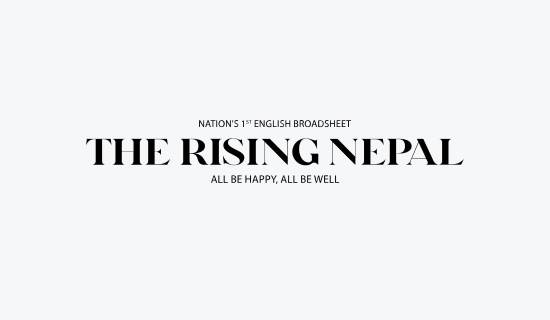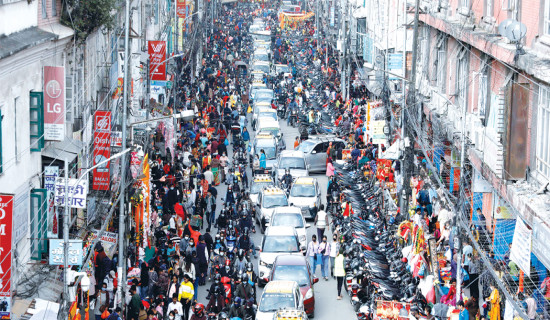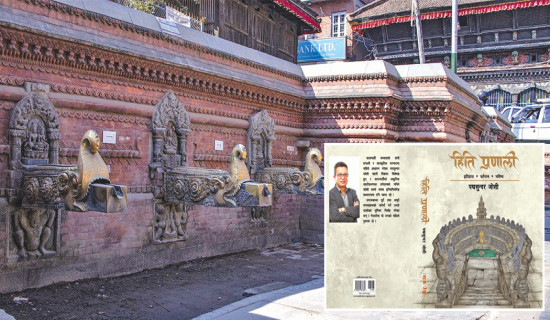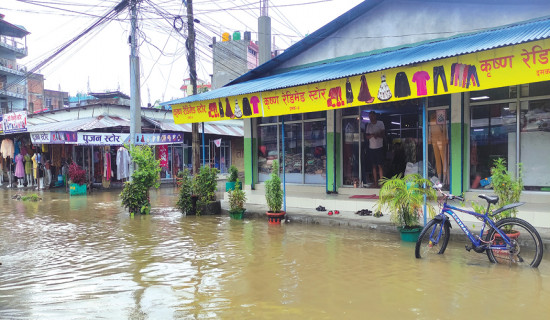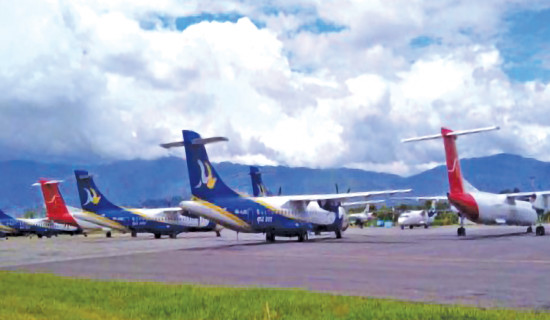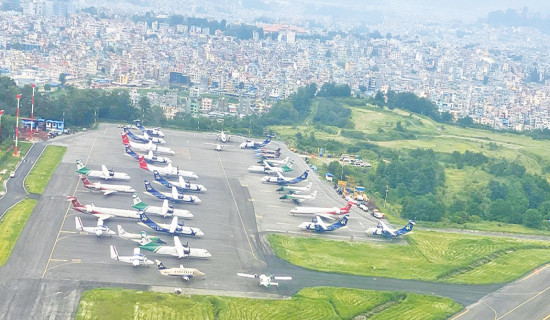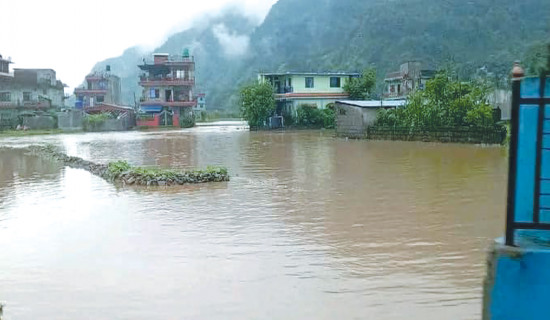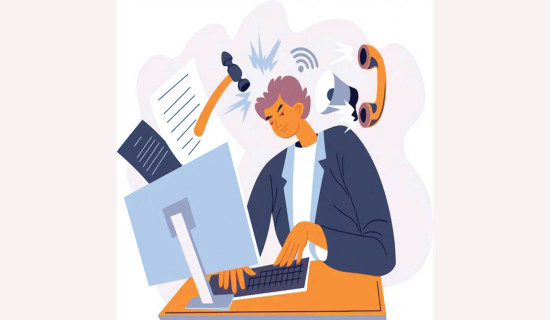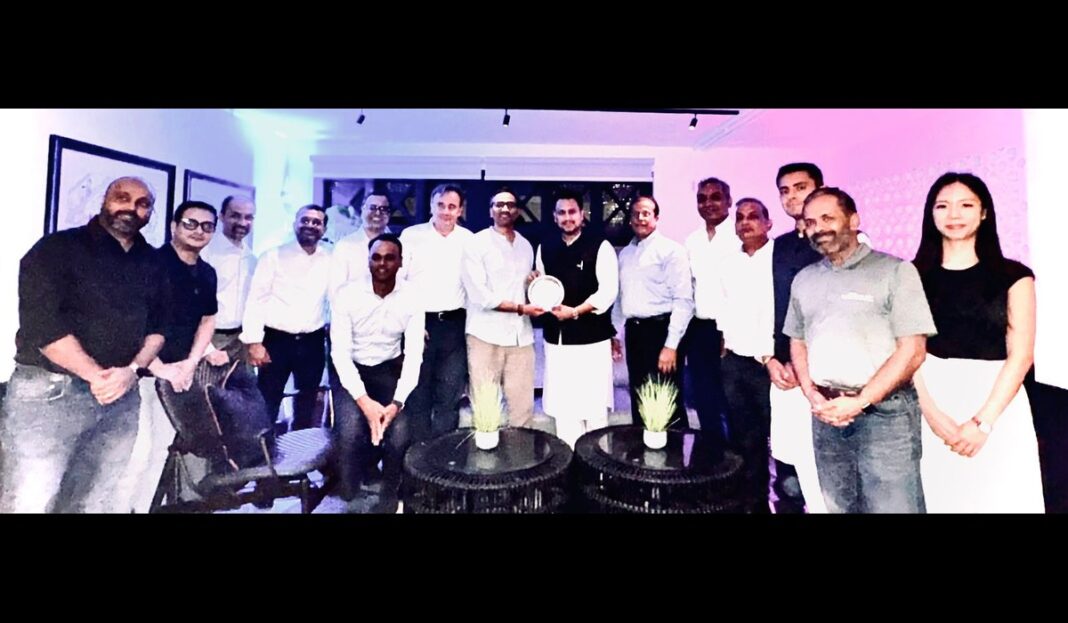- Friday, 24 October 2025
First Shrawan Monday marked
Hindu women across the country marked the first Monday of the Nepali month of Shrawan on July 18 after a gap of two years. Donned in green and yellow apparel, married and unmarried women visited various Shiva temples and shrines – Pashupatinath being the main one in Kathmandu. Many also fasted and coloured their hands with henna. Like other festivals, COVID-19 had affected the merry of these Mondays last year and the year before that. According to religious lore, Shrawan is one of Lord Shiva’s most favourite months and Monday is favourite day. Thus, worshipping him during this time is believed to bring good fortune and prosperity.
Work-Life Balance
All of us have at least two sides to our lives – a personal side and a professional side and often, one takes precedence over the other. For some, personal time is more important than work and friends and family come before other obligations. In contrast, others prefer focusing their energy on work and view non-work relationships as something to tend to only when free. However, both these practices are wrong. We need to devote ourselves equally to our work and home; we need to maintain a suitable work-life balance. This is needed to improve our physical, emotional and mental well-being and to allow us to give our all to both our workplaces and families.
On Journalistic Writing
Journalistic writing” seems to be the buzzword of the day. From schoolchildren to working professionals, everyone claims to want a “journalistic flair” in their articles. But what exactly is journalistic writing? Ask this and almost everyone will answer news.
Bikes, bikes everywhere, no space to walk!
This is John Smithlow’s second visit to Nepal. He arrived in the country last week with his granddaughter to roam around Kathmandu he remembered from his first trip in 1982. Back then, the valley was greener and the people were friendlier but the point that the 67-year-old UK national specifically wanted to highlight was, “The streets were emptier.” “There were no motorbikes back then,” he recalled. “One could roam around and take in the beauty of the city undisturbed.” “But now, that’s gone!” a flabbergasted Smithlow who was found at Ason on Wednesday exclaimed. “Why are there so many motorcycles in this city?” he questioned. Laxmi Amin had the same question. “It is disorienting,” the 38-year-old Indian in Lalitpur for the first time said. “Bikes, bikes everywhere! Hard to find space to walk.”
Padam Sunder Joshi’s ‘Hiti Pranali’ launched
An elongated stone spout protruding from the open mouth of the mythical Makar crocodile is what people think of when they think of Kathmandu’s traditional hitis. But that is only a narrow conception of what is, in fact, an elaborate system of urban water management, said scholar Padma Sunder Joshi. As he presented at the launch of his book ‘Hiti Pranali’ here on Wednesday, acknowledging a hiti through the fountain, elaborate as they may be, would be extremely erroneous if not downright ignorant. For hitis are more than what we see; they are an intricate system of interconnected parts all working in tandem to bring water to our settlements. They are a comprehensive entity designed by our ancestor millennia ago to not only quench the thirst of their communities but also irrigate their fields, prevent waterlogging of their residences and maintain the health of the groundwater.
Monsoon mayhem continues
Floods, landslides and heavy rains have affected 147 families and caused around Rs. 61.18 million in damages since April 14. The data released by the National Disaster Risk Reduction and Management Authority (NDRRMA) on Saturday shows that the country has had 63 landslides, 15 floods and 43 instances of torrential rain since the start of this Nepali year which have killed a total of 17 people and injured 20.
Be Sensitive To Heritages
A video surfaced online this Wednesday which showed a group of young men quarrelling with a senior citizen at Patan Durbar Square. The video showed them harassing the old man and threatening to send him to jail. One of them also claimed to be “from the media” and hurled obscenities. Thankfully, the locals and the Lalitpur Metropolitan City Police intervened and things did not escalate beyond verbal confrontation. A day later, the Mangalbazaar Police and heritage activists brought the youths in for questioning. They were released a short while later.
Delays, flight returns cause losses
Last Monday, June 20, Mahanish Jung Thapa boarded a Buddha Air flight at 7 pm from Kathmandu, hoping to reach his destination Bhadrapur in about 45 minutes. He was travelling to the city to attend his friend’s wedding happening the following day and was extremely excited when the aeroplane reached the Jhapa sky. The aircraft started making manoeuvres and he prepared himself for landing, only to be told that they would be returning to Kathmandu. After flying a cumulative distance of 320 nautical miles and spending nearly one and a half hours, Thapa ended up right where he had started. “This had never happened in my life where an airplane returned after reaching its destination,” he said.
Airliners start parking planes in airports outside Kathmandu
The Civil Aviation Authority of Nepal’s new rules requiring airline companies to park their aircrafts and conduct their first flight of the day from their designated operating bases came into effect from Monday. Under the rules, the airlines parked their planes at specified airports outside the Kathmandu Valley, including Bhairahawa, Bharatpur, Biratnagar, Chandragadhi, Dhangadhi, Janakpur, Manthali, Nepalgunj, Pokhara, Simara and Surkhet, on Monday night and took off from the same locations on Tuesday morning.
Monsoon comes crashing
With the onset of the monsoon season, the country has begun seeing heavy rains and rain-induced disasters. As per the bulletin issued by the National Disaster Risk Reduction and Management Authority (NDRRMA), downpour had caused more than Rs. 100,000 in damages in Tokha, Kathmandu and had damaged a house in Hemja, Kaski.
Impact Of Social Media On Journalism
Aashish MishraAt every seminar, workshop, training or discussion related to journalism these days, one topic always comes up – the impact of social media. In fact, it comes up so many times that the topic seems to have lost its value. Just like we take for granted the presence of water when we are thirsty (there is no conscious thought involved in drinking water; we do not stop to think of the composition of the liquid nor do we consider its value and importance, we just take a gulp and quench our thirst), we have taken for granted the availability of social media.But when we take a moment’s pause and compare the way things are today with how they were just 20 years ago, we see the true impact social media has had on this profession of news.First, social networking platforms have allowed readers to connect at a level that traditional print and broadcasting never did. People who have read the same article or watched the same video are aware of each other based on the “reactions” they have given or comments they have posted on social media. They can interact with each other at a personal level that just was not possible before.Social sites have built this same connection and interaction between audiences and media houses and journalists as well. People can now make their opinions known instantly by commenting, tagging or direct messaging. Journalists can and have now become celebrities, amassing a fan following based on the kinds of issues they cover and social media accounts have now become places for reporters to mix journalism with activism without editorial gatekeeping.Social media also helps create true news audiences. In the past, we had media audiences wherein people tuned into a specific TV channel or radio station or bought a particular newspaper they liked and consumed its news only. Now though, they get a variety of news from many different sources – even if they do not want to – because the algorithms of Facebook, Twitter or YouTube push content based on their and their friends’ activities. This may not necessarily be a good thing but the point is that social media exposes people to diverse perspectives and information.It might not be an exaggeration to claim that social media has revolutionised the way society consumes news and has detached it from the concept of media. Today, the media often follows the story first broken by citizens on their private social media handles and uses the information and visuals from their posts in their news. People go to specific pages and accounts to stay updated on current affairs. In their pursuit of accuracy, the news media have lost out to pages and people who have no qualms about posting falsehoods and propaganda. Today, what the people perceive as news may be a collection of unverified, unbalanced, unsourced and unstructured data thrown at the people to arouse emotions or incite actions. Social media has made news fast but cheap and has made it okay to sacrifice truthfulness for rapidity.Social media has also made consumers the true rulers of the news world. While in principle, the media have also been subservient to their audience, this was not really true in practice. The media gave the content they felt was necessary and the people had to either accept it or tune out. But now, if they do not like something, they can make it known through comments and shares. Social media reactions can annihilate a news organisation’s credibility and reputation and articles can go viral for all the wrong reasons. Social networking sites have made it very easy for the average person to have an impact in the news world and shape its output based on his/her moral philosophies and understanding. This, by no means, is bad though and people having power over social institutions is what democracies are all about. The effects of social media on journalism are wide and multidimensional. The rise of sites like Facebook and Twitter has pushed journalists to reform and evolve their craft. They have had to acquire tech literacy and media houses have had to develop infrastructure. Social media has also established itself as a mandatory platform for exposure, so much so that if an issue is not on social media, it is not considered news.
Hustle culture can be harmful to health
Kathmandu, June 17:Umesh Pathak cannot remember the last time he went on a holiday. In fact, he does not think he has taken a single day off from work in the last two years. “I feel anxious,” the 29-year-old banker said. “I get worried that if I do not work hard, I will fall behind.”This same anxiety also haunts Samsrita Dhakal, 26, who works as a communication and outreach consultant in non-governmental organisations. “Sickness or health, rain or shine, I cannot bring myself to miss work,” she said, adding that she would rather compromise on her personal life than professional engagements.Eesha Tuladhar also constantly finds herself at the office, even on weekends and off days. At 27, she knows she is at the prime of her life and should be out exploring her interests. But she fears that working less will hinder her progress. All three have unwittingly become a part – or rather victims – of a larger social phenomenon called hustle culture.As the name implies (hustle meaning a state of great activity), hustle culture is overworking to the point where it becomes a lifestyle, immersing oneself in so much work that there is no time for anything else. According to ‘hustlers,’ it usually manifests itself as extreme workaholism, the symptoms of which include the taking up multiple jobs or multiple responsibilities within the scope of the same job, an inability, and unwillingness, to maintain a work-life balance to the point where there remains no distinction between the two and an obsession with professional performance.“Basically, hustle culture means cocooning yourself in work and letting it mould your entire being,” said Aryan Rajput. Rajput, 30, calls himself a former hustler who “was willing to kill and die to advance in his career.” While working as a web designer in New Delhi, India from 2012 to 2018, Rajput said he had no semblance of a social or family life and in 2016, missed the birth of his first daughter to participate in a client presentation.But as his daughter grew, he realised that he had an obligation to be present in her life and so, quit his job and moved back home to Kathmandu.While there are no concrete statistics regarding hustle culture, most studies conducted in the United States, especially during the COVID-19 pandemic, show that it is most prevalent among Millennials. And psychologist Kusum Baral agrees.“Life is more expensive now than it was a generation ago and Millennials have to work two or more jobs to earn enough to sustain themselves,” she said. “But it is important not to overdo it.”Baral informed that hustle culture could lead to fatigue and burnout and too much work could also make one feel overwhelmed leading to nervous breakdowns and panic attacks. Working too much will also reduce one’s productivity, affecting the very performance that hustlers try frantically to maintain. The lack of personal time can also cause depression, she said.“Hustle culture is a self-defeating concept. We work double and end up giving half while also harming ourselves in the process,” she said. “Let us remember, all work and no play makes Johnny a dull boy.”
The Wonderful Courtyards
Hanumandhoka is a place of wonder and intrigue. Home to the monarchs of two dynasties, Malla and Shah, and the seat of the royals for centuries, the Hanumandhoka Durbar contains many exquisite structures and elements found nowhere else in Nepal and the world; one such element being its chowks (courtyards). While in the past, presumably when it was still the official residence of the country’s royal family, the Hanumandhoka palace complex is said to have had 35 big and small courtyards. But today it has only 11. Nevertheless, each of these 11 yards is a marvellous masterpiece of Malla, Shah and Rana architecture and displays unique culture and practices of the Kathmandu Valley.
Heed Environment
It might not be obvious and it is certainly not comfortable to think about but Nepal is in the midst of quite an environmental mess and nowhere is this more evident than in the capital city Kathmandu. The rivers here are dead, garbage covers the streets and intersections and the air is heavy with pollution. Our country is arguably fast becoming uninhabitable, just like the rest of the world. So perhaps now is the time to rethink our ways and get real about sustainable environmental protection. The path we are currently on leads to nothing but death and destruction so we must now change it starting with our dependency on fossil fuels.
Native nursery rhymes losing space
“Pani paryo, asina jharyo, Daiko rumal bhauju lai man paryo” (It rains, it hails/The sister-in-law likes the brother’s handkerchief) No sooner would a drop of water fall from the sky than Nitu Basnet would yell out this song.



